Oxidation of Glycerol in Base-Free Aqueous Solution Using Carbon-Supported Pt and PtSn Catalyst
Abstract
1. Introduction
2. Results and Discussion
2.1. Preparation and Characterisation of Support and Catalysts
2.2. Catalytic Experiments with Commercial Glycerol
2.3. Catalytic Test—Oxidation of Crude Glycerol
3. Materials and Methods
3.1. Preparation of Monometallic Catalysts
3.2. Preparation of Bimetallic Catalysts
3.3. Support and Catalyst Characterisation
3.4. Catalytic Test
4. Conclusions
Supplementary Materials
Author Contributions
Funding
Data Availability Statement
Acknowledgments
Conflicts of Interest
References
- Dou, J.; Zhang, B.; Liu, H.; Hong, J.; Yin, S.; Huang, Y.; Xu, R. Carbon supported Pt9Sn1 nanoparticles as an efficient nanocatalyst for glycerol oxidation. Appl. Catal. B Environ. 2016, 180, 78–85. [Google Scholar] [CrossRef]
- Zhou, C.-H.; Beltramini, J.N.; Fan, Y.-X.; Lu, G.Q. Chemoselective catalytic conversion of glycerol as a biorenewable source to valuable commodity chemicals. Chem. Soc. Rev. 2008, 37, 527–549. [Google Scholar] [CrossRef] [PubMed]
- Anitha, M.; Kamarudin, S.K.; Kofli, N.T. The potential of glycerol as a value-added commodity. Chem. Eng. 2016, 295, 119–130. [Google Scholar] [CrossRef]
- Chiosso, M.E.; Lick, I.D.; Casella, M.L.; Merlo, A.B. Acid functionalized carbons as catalyst for glycerol etherification with benzyl alcohol. Braz. J. Chem. Eng. 2020, 37, 129–137. [Google Scholar] [CrossRef]
- Chiosso, M.E.; Casella, M.L.; Merlo, A.B. Synthesis and catalytic evaluation of acidic carbons in the etherification of glycerol obtained from biodiesel production. Catal. Today 2021, 372, 107–114. [Google Scholar] [CrossRef]
- Skrzynska, E.; Zaid, S.; Girardon, J.-S.; Capron, M.; Dumeignil, F. Catalytic behavior of four different supported noble metals in the crude glycerol oxidation. Appl. Catal. A Gen. 2015, 499, 89–100. [Google Scholar] [CrossRef]
- El Roz, A.; Fongarland, P.; Dumeignil, F.; Capron, M. Glycerol to Glyceraldehyde Oxidation Reaction Over Pt-based Catalysts Under Base-Free Conditions. Front. Chem. 2019, 7, 156. [Google Scholar] [CrossRef]
- Yang, L.; Li, X.; Chen, P.; Hou, Z. Selective oxidation of glycerol in a base-free aqueous solution: A short review. Chin. J. Catal. 2019, 40, 1020–1034. [Google Scholar] [CrossRef]
- Ferrari, L.; Tuler, F.; Promancio, E.; Guse, L.; García Touza, D.; Casas, C.; Comelli, R.A. Glycerol as raw material to an Argentinian biorefinery. Catal. Today 2022, 394–396, 247–255. [Google Scholar] [CrossRef]
- Ribeiro, L.S.; Rodrigues, E.G.; Delgado, J.J.; Chen, X.; Pereira, M.F.R.; Órfaõ, J.J.M. Pd, Pt, and Pt–Cu Catalysts Supported on Carbon Nanotube (CNT) for the Selective Oxidation of Glycerol in Alkaline and Base-Free Conditions. Ind. Eng. Chem. Res. 2016, 55, 8548–8556. [Google Scholar] [CrossRef]
- Kondrat, S.A.; Miedziak, P.J.; Douthwaite, M.; Brett, G.L.; Davies, T.E.; Morgan, D.J.; Edwards, J.K.; Knight, D.W.; Kiely, C.J.; Taylor, S.H.; et al. Base-Free Oxidation of Glycerol Using Titania-Supported Trimetallic Au–Pd–Pt Nanoparticles. ChemSusChem 2014, 7, 1326–1334. [Google Scholar] [CrossRef] [PubMed]
- Yang, L.; He, T.; Lai, C.; Chen, P.; Hou, Z. Selective oxidation of glycerol with oxygen in base-free solution over N-doped-carbon-supported Sb@PtSb2 hybrid. Chin. J. Catal. 2020, 41, 494–502. [Google Scholar] [CrossRef]
- Liang, D.; Gao, J.; Wang, J.H.; Chen, P.; Wei, Y.F.; Hou, Z.Y. Bimetallic Pt―Cu catalysts for glycerol oxidation with oxygen in a base-free aqueous solution. Catal. Commun. 2011, 12, 1059–1062. [Google Scholar] [CrossRef]
- Villa, A.; Veith, G.M.; Prati, L. Selective Oxidation of Glycerol under Acidic Conditions Using Gold Catalysts. Angew. Chem. Int. Ed. 2010, 49, 4499–4502. [Google Scholar] [CrossRef] [PubMed]
- Demirel-Gülen, S.; Lucas, M.; Claus, P. Liquid phase oxidation of glycerol over carbon supported gold catalysts. Catal. Today 2005, 102–103, 166–172. [Google Scholar] [CrossRef]
- Namdeo, A.; Mahajani, S.M.; Suresh, A.K. Palladium catalysed oxidation of glycerol—Effect of catalyst support. J. Mol. Catal. A Chem. 2016, 421, 45–56. [Google Scholar] [CrossRef]
- Chan-Thaw, C.E.; Campisi, S.; Wang, D.; Prati, L.; Villa, A. Selective Oxidation of Raw Glycerol Using Supported AuPd Nanoparticles. Catalysts 2015, 5, 131–144. [Google Scholar] [CrossRef]
- Carrettin, S.; McMorn, P.; Johnston, P.; Griffin, K.; Kiely, C.J.; Hutchings, G.J. Oxidation of glycerol using supported Pt, Pd and Au catalysts. Phys. Chem. Chem. Phys. 2003, 5, 1329–1336. [Google Scholar] [CrossRef]
- Rodrigues, E.G.; Pereira, M.F.R.; Chen, X.; Delgado, J.J.; Órfão, J.J.M. Selective Oxidation of Glycerol over Platinum-Based Catalysts Supported on Carbon Nanotubes. Ind. Eng. Chem. Res. 2013, 52, 17390–17398. [Google Scholar] [CrossRef]
- Gil, S.; Cuenca, N.; Romero, A.; Valverde, J.L.; Sánchez-Silva, L. Optimization of the synthesis procedure of microparticles containing gold for the selective oxidation of glycerol. Appl. Catal. A Gen. 2014, 472, 11–20. [Google Scholar] [CrossRef]
- Zhou, J.; Hu, J.; Zhang, X.; Li, J.; Jiang, K.; Liu, Y.; Zhao, G.; Wang, X.; Chu, H. Facet effect of Pt nanocrystals on catalytical properties toward glycerol oxidation reaction. J. Catal. 2020, 381, 434–442. [Google Scholar] [CrossRef]
- Sun, Y.; Li, X.; Wang, J.; Ning, W.; Fu, J.; Lu, X.; Hou, Z. Carbon film encapsulated Pt NPs for selective oxidation of alcohols in acidic aqueous solution. Appl. Catal. B Environ. 2017, 218, 538–544. [Google Scholar] [CrossRef]
- Liang, D.; Gao, J.; Wang, J.; Chen, P.; Hou, Z.; Zheng, X. Selective oxidation of glycerol in a base-free aqueous solution over different sized Pt catalysts. Catal. Commun. 2009, 10, 1586–1590. [Google Scholar] [CrossRef]
- Roy, D.; Subramaniam, B.; Chaudhari, R.V. Cu-Based Catalysts Show Low Temperature Activity for Glycerol Conversion to Lactic Acid. ACS Catal. 2011, 1, 548–551. [Google Scholar] [CrossRef]
- Nie, R.F.; Liang, D.; Shen, L.; Gao, J.; Chen, P.; Hou, Z.Y. Selective oxidation of glycerol with oxygen in base-free solution over MWCNTs supported PtSb alloy nanoparticles. Appl. Catal. B Environ. 2012, 127, 212–220. [Google Scholar] [CrossRef]
- Rodriguez-Reinoso, F. The Role of Carbon Materials in Heterogeneous Catalysis. Carbon 1998, 36, 159–175. [Google Scholar] [CrossRef]
- Ramallo-López, J.M.; Santori, G.F.; Giovanetti, L.; Casella, M.L.; Ferretti, O.A.; Requejo, F.G. XPS and XAFS Pt L2,3-Edge Studies of Dispersed Metallic Pt and PtSn Clusters on SiO2 Obtained by Organometallic Synthesis: Structural and Electronic Characteristics. J. Phys. Chem. B 2003, 107, 11441–11451. [Google Scholar] [CrossRef]
- Siri, G.J.; Ramallo-López, M.J.; Casella, M.L.; Fierro, J.L.G.; Requejo, F.G.; Ferretti, O.A. XPS, and EXAFS study of supported PtSn catalysts obtained by surface organometallic chemistry on metals. Application to the isobutane dehydrogenation. Appl. Catal. A Gen. 2005, 278, 239–249. [Google Scholar] [CrossRef]
- Pastor-Pérez, L.; Merlo, A.; Buitrago-Sierra, R.; Casella, M.; Sepúlveda-Escribano, A. Bimetallic PtSn/C catalysts obtained via SOMC/M for glycerol steam reforming. J. Colloid Interface Sci. 2015, 459, 160–166. [Google Scholar] [CrossRef]
- Ishitobi, H.; Ino, Y.; Nakagawa, N. Anode catalyst with enhanced ethanol electrooxidation activity by effective interaction between Pt-Sn-SiO2 for a direct ethanol fuel cell. Int. J. Hydrogen Energy 2017, 42, 26897–26904. [Google Scholar] [CrossRef]
- Wagner, C.D. NIST X-ray Photoelectron Spectroscopy Database; NIST: Gaithersburg, MD, USA, 1989. [Google Scholar]
- Serrano-Ruiz, J.C.; Sepúlveda-Escribano, A.; Rodríguez-Reinoso, F. Bimetallic PtSn/C catalysts promoted by ceria: Application in the nonoxidative dehydrogenation of isobutane. J. Catal. 2007, 246, 158–165. [Google Scholar] [CrossRef]
- Zhang, Y.W.; Xue, M.W.; Zhou, Y.M.; Zhang, H.X.; Wang, W.; Wang, Q.L.; Sheng, X.L. Propane dehydrogenation over Ce-containing ZSM-5 supported platinum–tin catalysts: Ce concentration effect and reaction performance analysis. RSC Adv. 2016, 6, 29410–29422. [Google Scholar] [CrossRef]
- Ruiz-Martínez, J.; Coloma, F.; Sepúlveda-Escribano, A.; Anderson, J.A.; Rodríguez-Reinoso, F. Effect of tin content and reduction temperature on the catalytic behaviour of PtSn/TiO2 catalysts in the vapour-phase hydrogenation of crotonaldehyde. Catal. Today 2008, 133–135, 35–41. [Google Scholar] [CrossRef]
- Wagner, C.D.; Naumkin, A.V.; Kraut-Vass, A.; Allison, J.W.; Powell, C.J.; Rumble, J.R. NIST X-ray Photoelectron Spectroscopy Database; NIST: Gaithersburg, MD, USA, 2007. [Google Scholar]
- Calvillo, L.; Mendez De Leoc, L.; Thompson, S.J.; Price, S.W.T.; Calvo, E.J.; Russell, A.E. In situ determination of the nanostructure effects on the activity, stability and selectivity of Pt-Sn ethanol oxidation catalysts. Electroanal. Chem. 2018, 819, 136–144. [Google Scholar] [CrossRef]
- Massalskii, T.B. Binary Alloy Phase Diagrams; ASTM: Philadelphia, PA, USA, 1986. [Google Scholar]
- Merlo, A.B.; Machado, B.F.; Vetere, V.; Faria, J.F.; Casella, M.L. PtSn/SiO2 catalysts prepared by surface-controlled reactions for the selective hydrogenation of cinnamaldehyde. Appl. Catal. A Gen. 2010, 383, 43–49. [Google Scholar] [CrossRef]
- Merlo, A.B.; Vetere, V.; Ruggera, J.F.; Casella, M.L. Bimetallic PtSn catalyst for the selective hydrogenation of furfural to furfuryl alcohol in liquid-phase. Catal. Commun. 2009, 10, 1665–1669. [Google Scholar] [CrossRef]
- Pastor-Pérez, L.; Sepúlveda-Escribano, A. Low temperature glycerol steam reforming on bimetallic PtSn/C catalysts: On the effect of the Sn content. Fuel 2017, 194, 222–228. [Google Scholar] [CrossRef]
- Besson, M.; Blackburn, A.; Gallezot, P.; Kozynchenko, O.; Pigamo, A.; Tennison, S. Oxidation with air of cyclohexanone to carboxylic diacids on carbon catalysts. Top. Catal. 2000, 13, 253–257. [Google Scholar] [CrossRef]
- Sullivan, J.A.; Burnham, S. The selective oxidation of glycerol over model Au/TiO2 catalysts—The influence of glycerol purity on conversion and product selectivity. Catal. Commun. 2015, 56, 72–75. [Google Scholar] [CrossRef]
- Ferretti, O.A.; Casella, M.L.; Basset, M.; Psaro, R.; Roberto, D.; Ugo, R. (Eds.) Modern Surface Organometallic Chemistry; Wiley—VCH Verlag GmbH: Weinheim, Germany, 2009; pp. 239–291. [Google Scholar]
- Musci, J.J.; Merlo, A.B.; Casella, M.L. Aqueous phase hydrogenation of furfural using carbon-supported Ru and RuSn catalysts. Catal. Today 2017, 296, 43–50. [Google Scholar] [CrossRef]
- Bailón-García, E.; Carrasco-Marín, F.; Pérez-Cadenas, A.F.; Maldonado-Hodar, F.J. Selective hydrogenation of citral by noble metals supported on carbon xerogels: Catalytic performance and stability. Appl. Catal. A Gen. 2016, 512, 63–73. [Google Scholar] [CrossRef]
- Wagner, C.D.; Davis, L.E.; Zeller, M.V.; Taylor, J.A.; Raymond, R.H.; Gale, L.H. Empirical atomic sensitivity factors for quantitative analysis by electron spectroscopy for chemical analysis. Surf. Interface Anal. 1981, 3, 211–225. [Google Scholar] [CrossRef]
- Faroppa, M.L.; Musci, J.J.; Chiosso, M.E.; Caggiano, C.G.; Bideberripe, H.P.; García Fierro, J.L.; Siri, G.J.; Casella, M.L. Oxidation of glycerol with H2O2 on Pb-promoted Pd/γ-Al2O3 catalysts. Chin. J. Catal. 2016, 37, 1982–1990. [Google Scholar] [CrossRef]
- Ramachandran, P.; Chaudhari, R. Topics in Chemical Engineering; Vol.2 Three phase catalytic reactors; Gordon and Breach Science: New York, NY, USA, 1983; pp. 200–251. ISBN 0677056508. [Google Scholar]
- Gallezot, P.; Richard, D. Selective Hydrogenation of α,β-Unsaturated Aldehydes. Catal. Rev. 1998, 40, 81–126. [Google Scholar] [CrossRef]
- Neri, G.; Bonaccorsi, L.; Mercadante, L.; Galvagno, S. Kinetic Analysis of Cinnamaldehyde Hydrogenation over Alumina-Supported Ruthenium Catalysts. Ind. Eng. Chem. Res. 1997, 36, 3554–3562. [Google Scholar] [CrossRef]
- Meille, V.; Pestre, N.; Fongarland, P.; de Bellefon, C. Gas/Liquid Mass Transfer in Small Laboratory Batch Reactors: Comparison of Methods. Ind. Eng. Chem. Res. 2004, 43, 924–927. [Google Scholar] [CrossRef]
- Lucas Martínez, A. Transferencia de Materia en Tanques Agitados: Disolución de Sólidos Puros. Doctoral Thesis, Facultad de Ciencias Químicas, Universidad Complutense de Madrid, Madrid, Spain, 2015. Available online: https://books.google.com.ar/books/about/Transferencia_de_materia_en_tanques_agit.html?id=caDLjgEACAAJ&redir_esc=y (accessed on 13 June 2023).
- Cheng, N.-S. Formula for the Viscosity of a Glycerol−Water Mixture. Ind. Eng. Chem. Res. 2008, 47, 3285–3288. [Google Scholar] [CrossRef]
- Volk, A.; Kähler, C.J. Density model for aqueous glycerol solutions. Exp. Fluids 2018, 59, 75. [Google Scholar] [CrossRef]
- Wilke, C.R.; Chang, P. Correlation of diffusion coefficients in dilute solutions. AIChE J. 1955, 1, 264–270. [Google Scholar] [CrossRef]
- Ma, Y.; Gan, J.; Pan, M.; Zhang, Y.; Fu, W.; Duan, X.; Chen, W.; Chen, D.; Qian, G.; Zhou, X. Reaction mechanism and kinetics for Pt/CNTs catalysed base-free oxidation of glycerol. Chem. Eng. Sci. 2019, 203, 228–236. [Google Scholar] [CrossRef]
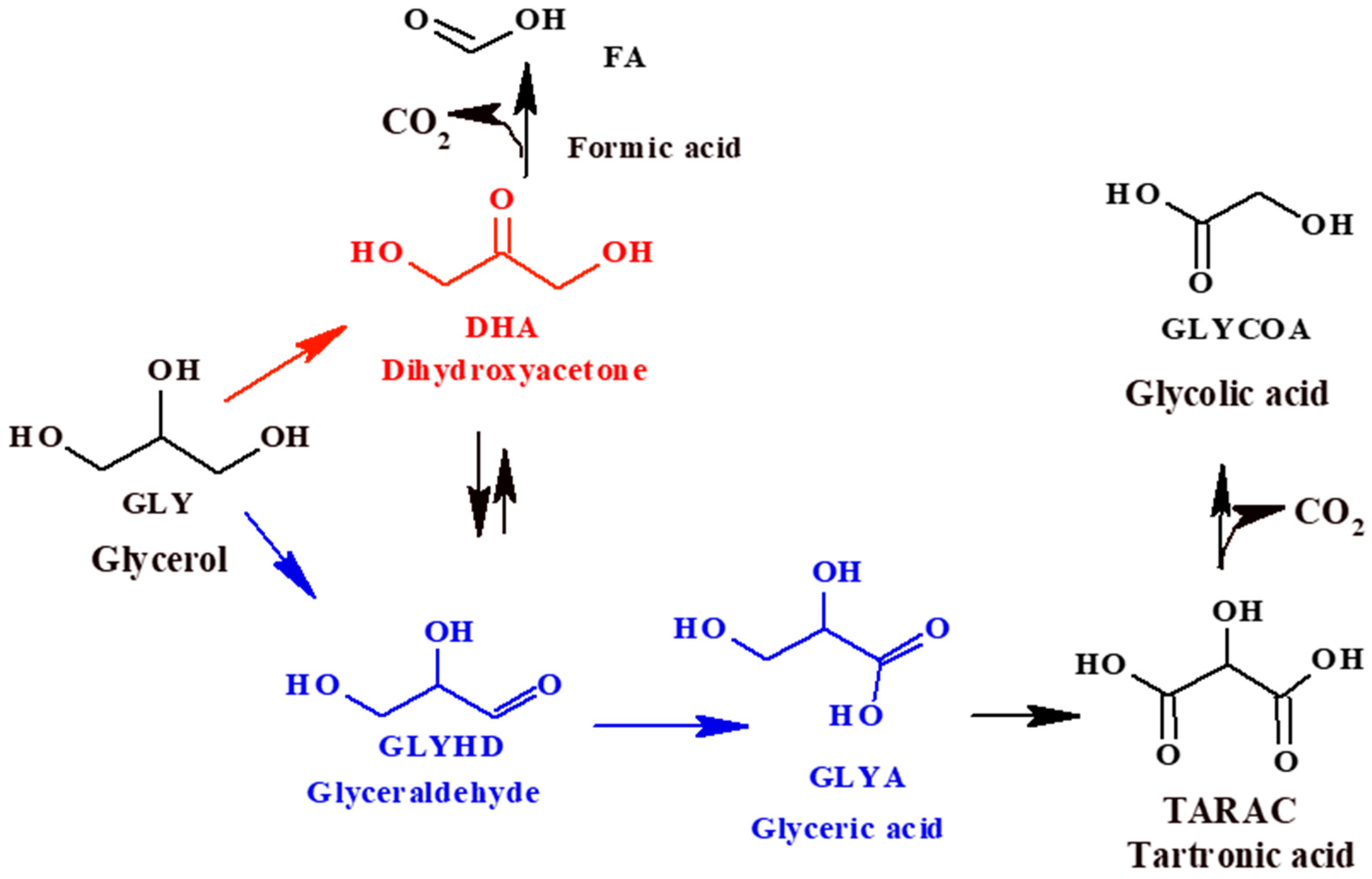
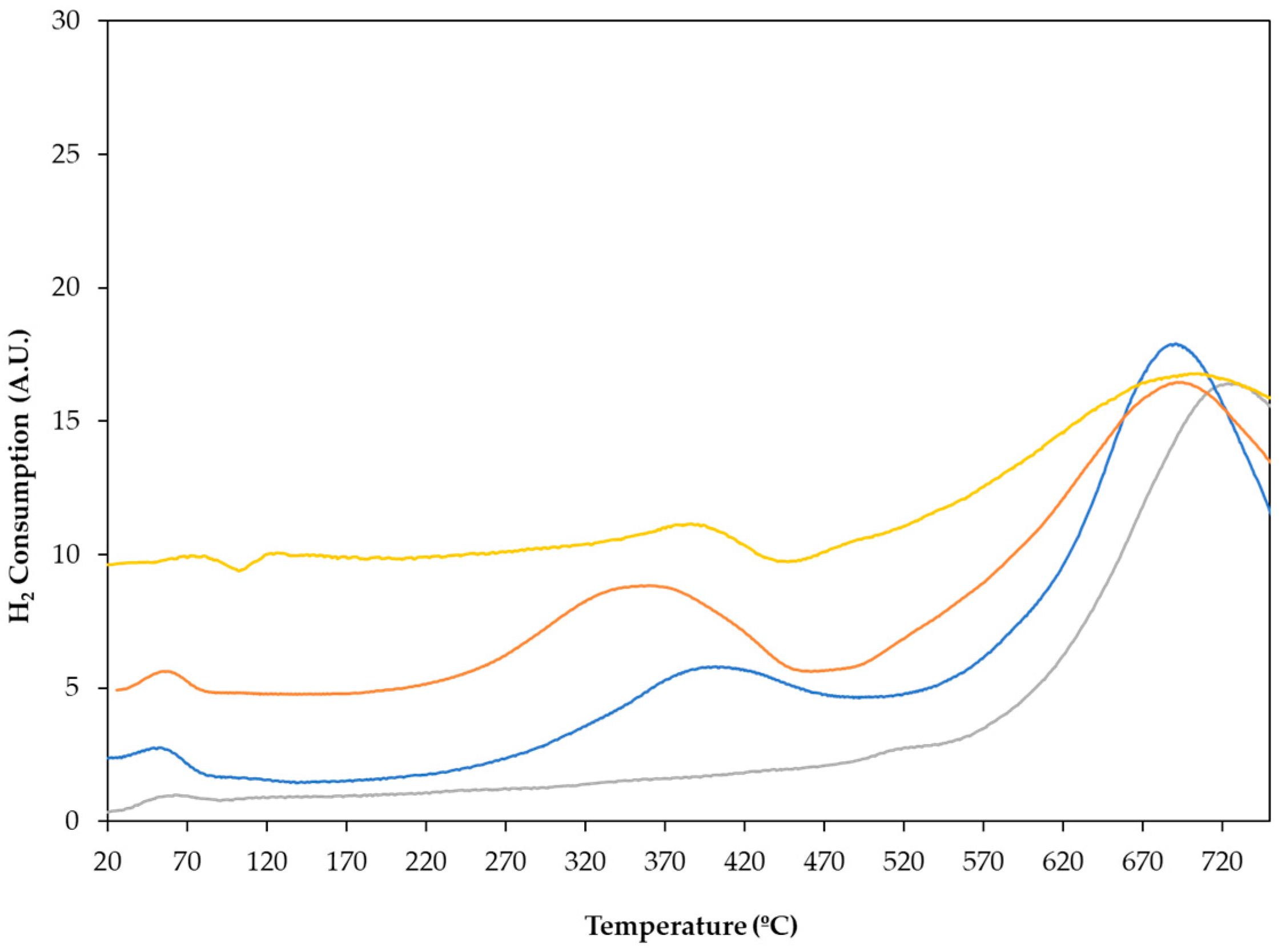
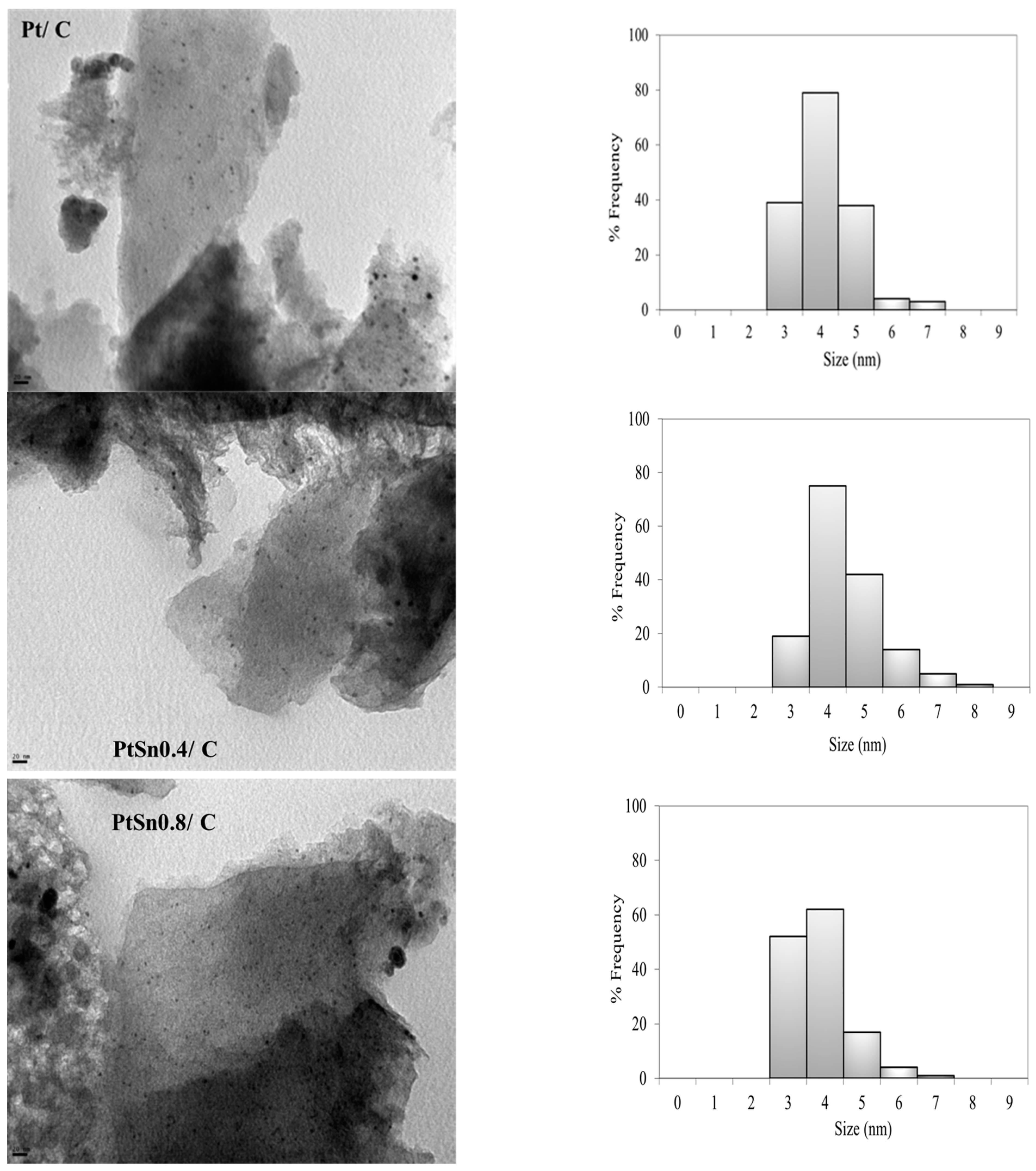
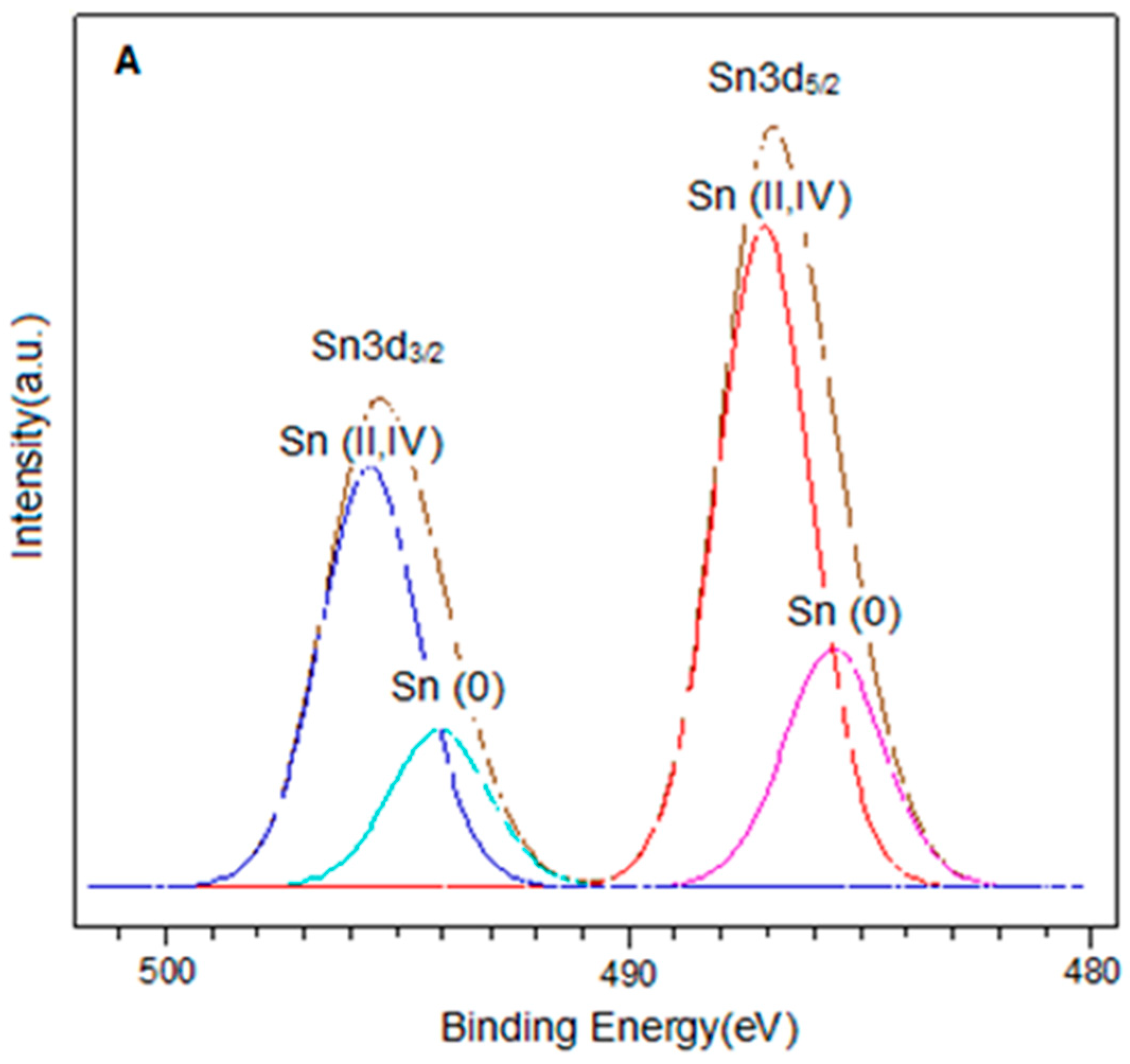
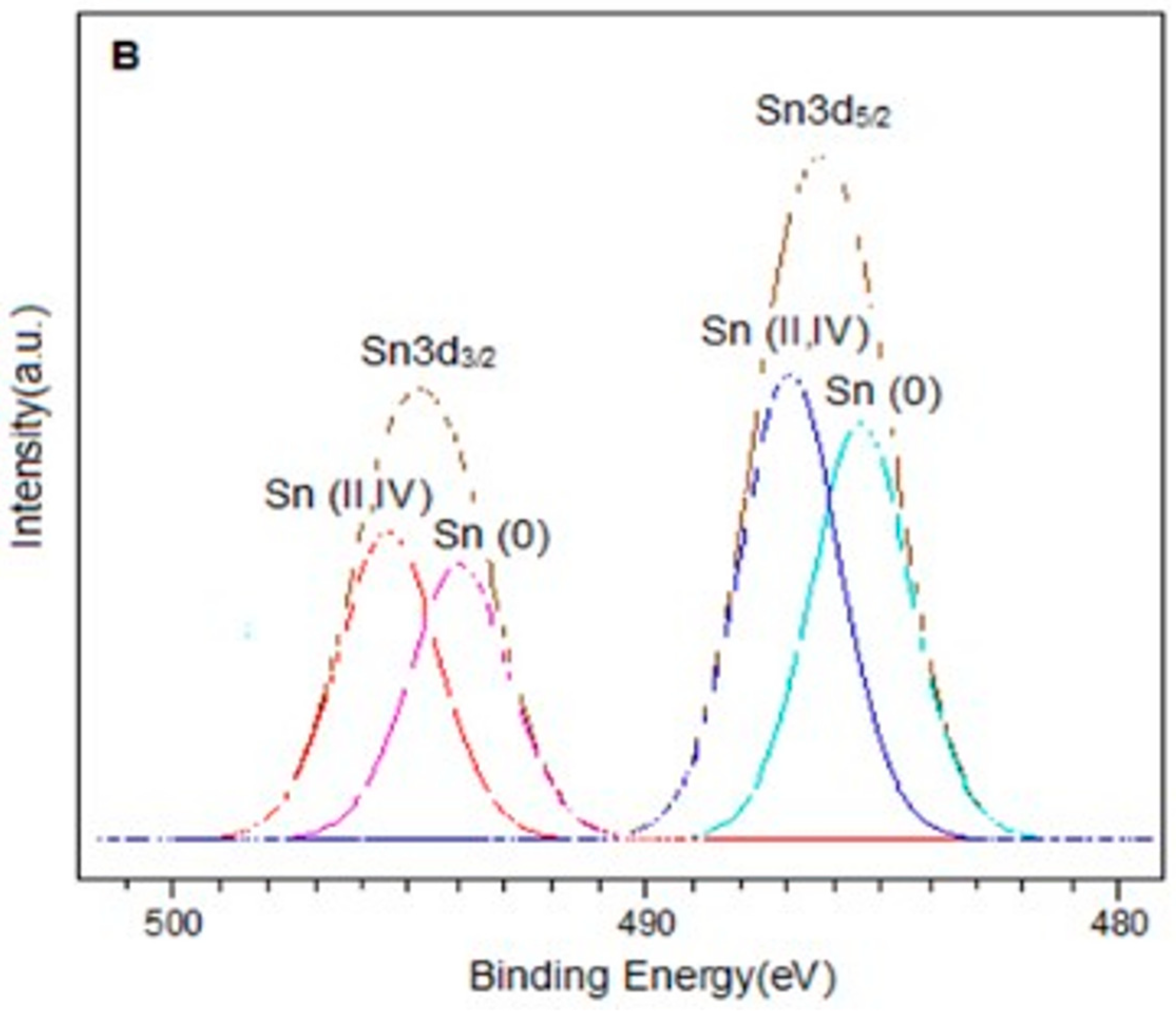
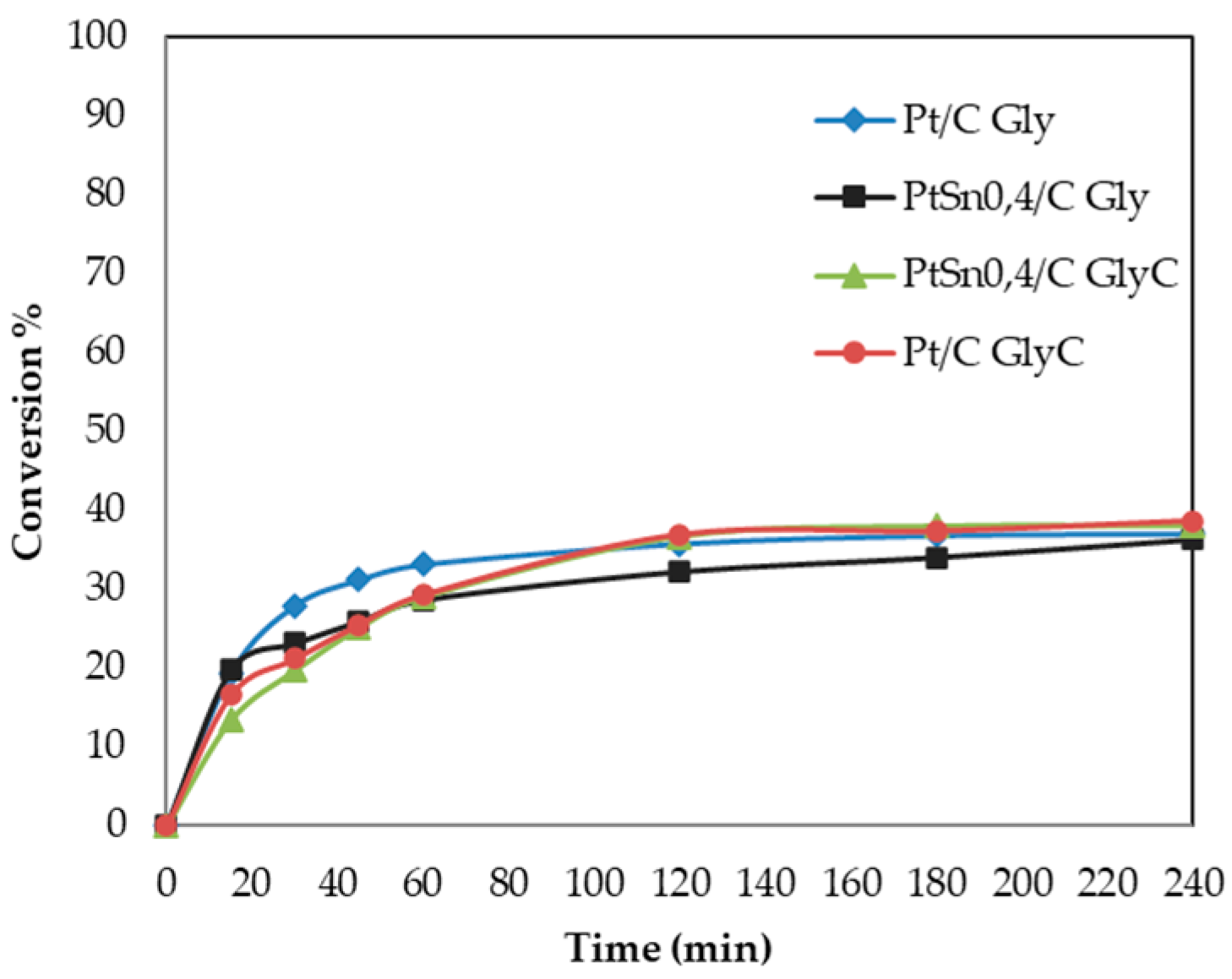
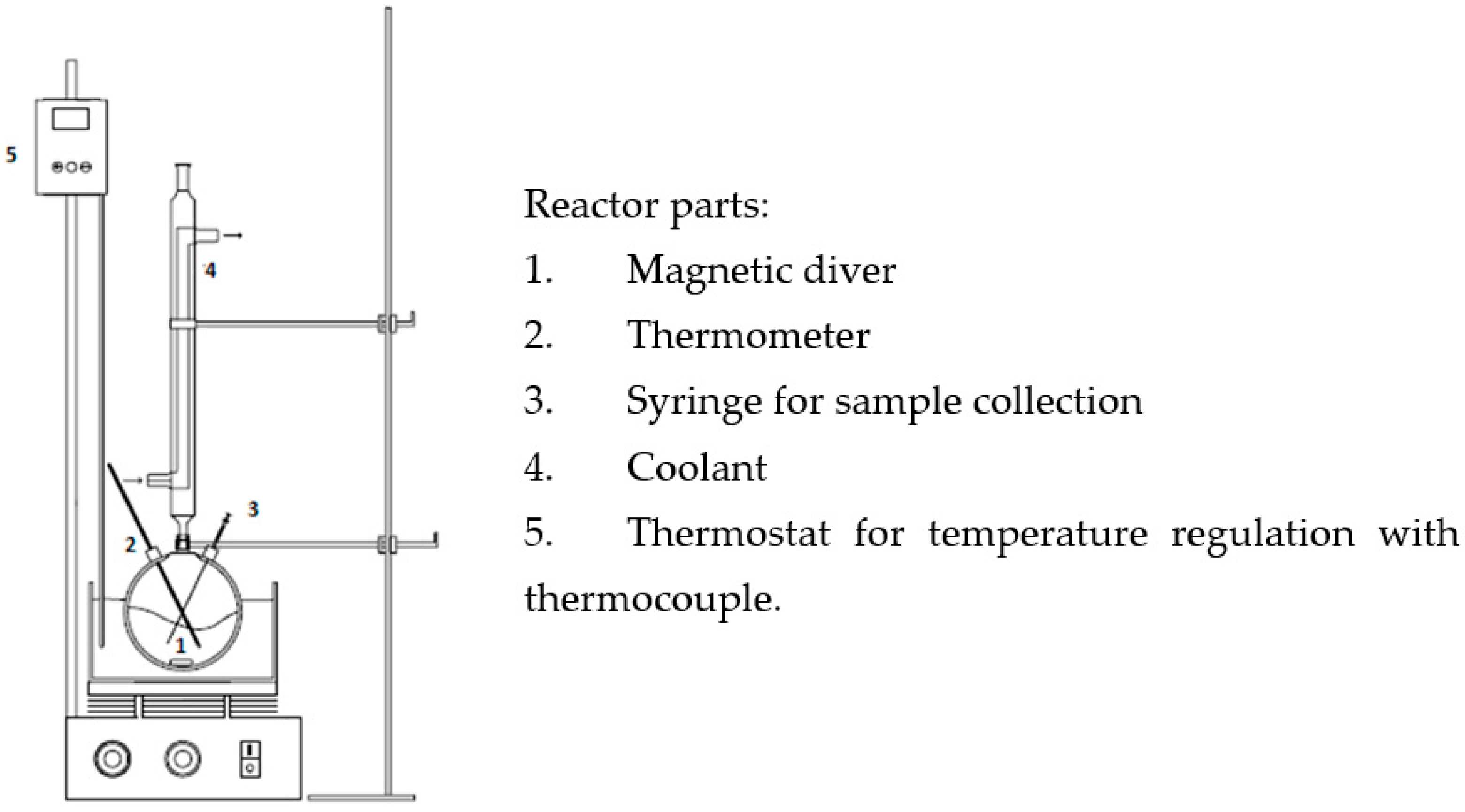
| Catalyst | % Pt | Sn/Pt 1 | dTEM (nm) | % D 2 |
|---|---|---|---|---|
| Pt/C | 1.05 | --- | 4.0 | 27 |
| PtSn0.4/C | 1.05 | 0.42 | 4.4 | 25 |
| PtSn0.8/C | 1.05 | 0.83 | 3.7 | 29 |
| Catalyst | BE Pt4f7/2 (eV) | BE Sn3d5/2 (eV) | Sn(0)/Sn Total 1 | Sn(0)/Pt |
|---|---|---|---|---|
| Pt/C | 71.3 | ----- | ------ | ------- |
| PtSn0.4/C | 71.2 | 485.5–487.0 | 0.27 | 0.13 |
| PtSn0.8/C | 71.2 | 485.4–486.9 | 0.46 | 0.48 |
| Catalysts | TOF (s−1) | Conversion (%) 1 | Selectivity (%) 2 | ||||
|---|---|---|---|---|---|---|---|
| DHA | GlyA | TA | GlyHD | Other | |||
| Pt/C | 17.6 | 37.0 | 26.0 | 57.1 | 1.7 | 0.3 | 14.9 |
| PtSn0.4/C | 20.5 | 36.3 | 96.9 | 1.9 | 1.2 | -- | -- |
| PtSn0.8/C | 3.0 | 20.1 | 92.3 | 5.2 | 2.1 | -- | 0.4 |
| Catalysts | Sample Gly | Conversion (%) 1 | Selectivity (%) 2 | |||
|---|---|---|---|---|---|---|
| DHA | GlyA | GlyHD | Other | |||
| Pt/C | GlyC | 39 | 17.4 | 52.4 | 9.9 | 20.3 |
| PtSn0.4/C | GlyC | 38 | 14.2 | 79.2 | 5.9 | 0.7 |
| PtSn0.4/C | GlyC90 | 40.4 | 24.8 | 63.6 | 4.1 | 7.5 |
| Catalyst | T (°C) 1 | Wt. (g) 2 | Reaction Time (h) | Ci (mmol L−1) 3 | Cf (mmol L−1) 3 | Sn/Pt 4 |
|---|---|---|---|---|---|---|
| PtSn0.4/C | 90 | 1.01 | 4.5 | 3.04 | 0.84 | 0.42 |
| PtSn0.8/C | 150 | 1.54 | 4.0 | 6.09 | 1.83 | 0.83 |
| Sample | % Gly | % Moisture | % Ash | % MeOH | % MONG 1 |
|---|---|---|---|---|---|
| GlyC | 82 | 12.3 | 4.8 | 0.08 | 0.8 |
| GlyC90 | 90 | 2.4 | 5.4 | 0.01 | 1.9 |
Disclaimer/Publisher’s Note: The statements, opinions and data contained in all publications are solely those of the individual author(s) and contributor(s) and not of MDPI and/or the editor(s). MDPI and/or the editor(s) disclaim responsibility for any injury to people or property resulting from any ideas, methods, instructions or products referred to in the content. |
© 2023 by the authors. Licensee MDPI, Basel, Switzerland. This article is an open access article distributed under the terms and conditions of the Creative Commons Attribution (CC BY) license (https://creativecommons.org/licenses/by/4.0/).
Share and Cite
Faroppa, M.L.; Chiosso, M.E.; Musci, J.J.; Ocsachoque, M.A.; Merlo, A.B.; Casella, M.L. Oxidation of Glycerol in Base-Free Aqueous Solution Using Carbon-Supported Pt and PtSn Catalyst. Catalysts 2023, 13, 1071. https://doi.org/10.3390/catal13071071
Faroppa ML, Chiosso ME, Musci JJ, Ocsachoque MA, Merlo AB, Casella ML. Oxidation of Glycerol in Base-Free Aqueous Solution Using Carbon-Supported Pt and PtSn Catalyst. Catalysts. 2023; 13(7):1071. https://doi.org/10.3390/catal13071071
Chicago/Turabian StyleFaroppa, María L., María E. Chiosso, Juan J. Musci, Marco A. Ocsachoque, Andrea B. Merlo, and Mónica L. Casella. 2023. "Oxidation of Glycerol in Base-Free Aqueous Solution Using Carbon-Supported Pt and PtSn Catalyst" Catalysts 13, no. 7: 1071. https://doi.org/10.3390/catal13071071
APA StyleFaroppa, M. L., Chiosso, M. E., Musci, J. J., Ocsachoque, M. A., Merlo, A. B., & Casella, M. L. (2023). Oxidation of Glycerol in Base-Free Aqueous Solution Using Carbon-Supported Pt and PtSn Catalyst. Catalysts, 13(7), 1071. https://doi.org/10.3390/catal13071071




